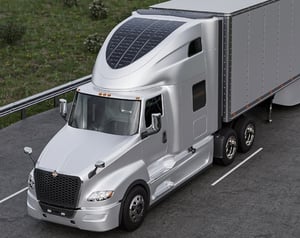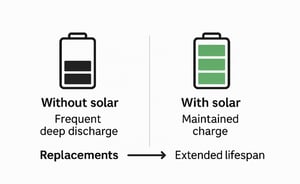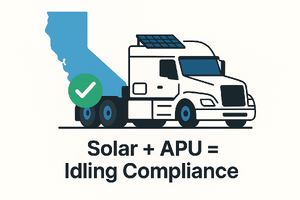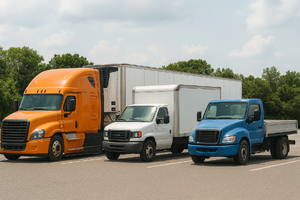What's The Return on Investment for a Commercial Trucking Solar Solution?

NOTE: Several images in this post are stylized to show solar panels mounted on commercial trucks clearly. In real-world applications, panels are typically flush-mounted and low-profile, making them much less visible.
If your fleet isn’t using solar, you’re leaving money on the table.
Between wasted fuel from idling, premature battery replacements, and costly jump-starts, the losses add up fast.
A properly installed solar system can significantly reduce these expenses, with many fleets achieving full payback in 8-24 months depending on the application.
This isn’t just about going green. It’s about achieving lean operations, boosting uptime, and driving tangible savings.
In this post, we’ll break down what a truck solar system really costs, where the savings come from, and how long it takes to pay off.
We’ll also share estimated ROI data by fleet type, common mistakes to avoid, and provide guidance on how to maximize your investment.
Let’s break down the numbers.
Take this blog post with you!
Upfront Investment: What Does a Truck Solar Solution Cost?

Equipment Costs
A typical truck-mounted solar solution ranges from $500 to $2,500 per vehicle, depending on:
- Panel size and wattage
- Charge controller quality
- Vehicle integration complexity
Installation Costs
Labor costs vary by installer, and many fleets handle the installation in-house. Typical installation time ranges from 1-3 technician-hours (depending on the application).
Simpler, low-flex mounting methods — such as PowerFilm’s — reduce installation time, minimize panel damage during installation, and ensure the panel you install outputs its rated power from day one.
Maintenance Requirements
Solar systems are nearly maintenance-free. Occasional cleaning or diagnostic checks may be needed, but there are no moving parts or fuel.
A properly installed system can operate for years with minimal attention.
How Solar Saves You Money
Reduced Fuel Use from Less Idling

Hotel loads — HVAC, CPAP machines, cabin lighting, infotainment systems — typically draw power while parked.
Even when a driver engages the battery disconnect, there are still parasitic draws from telematics systems and other devices.
Without solar power, that energy often comes from idling the engine, which burns fuel.
- Fuel saved: 200–400 gallons/year
- Assuming $4.00/gallon: $800–$1,600/year in savings
Longer Battery Life

Solar keeps batteries fully charged and prevents deep discharge cycles, which are a leading cause of premature failure.
- Battery replacement cost: $200–$350 per battery (2-4 battery systems, depending on the vehicle).
- Solar can prevent 1–2 replacements per year, per truck.
Discover how solar energy keeps batteries charged and prevents no-starts in our article on maintaining truck starting battery reliability with solar.
Fewer Downtime Events

Dead batteries mean jump-starts, missed routes, and revenue lost.
Solar reduces no-starts and extends operational readiness. Explore how solar cuts idle time and boosts uptime in this post on improving commercial trucking efficiency with solar.
- Avoiding even one jump-start (which often costs more than $1,000) can justify the investment.
- Less downtime also means fewer delays, fewer missed delivery windows, and higher driver satisfaction.
Helps Meet Compliance Requirements

Solar plays a significant role in reducing engine idling, particularly when combined with auxiliary power units (APUs). By powering hotel loads, such as HVAC systems, lighting, and electronics, solar energy enables trucks to remain compliant with anti-idling laws in states like California.
Reducing idle time not only cuts emissions but also lowers fuel costs and engine wear, making it a smart strategy for both regulatory compliance and operational efficiency.
Discover how solar energy supports diesel and electric APUs in reducing idling, lowering emissions, and meeting anti-idling regulations in our APU integration blog post.
ROI by Fleet Type

|
Fleet Type |
Solar Use Case |
Typical Payback |
|
Sleeper Cab (Long-Haul) |
Offsets hotel loads, idle time |
8-12 months |
|
Reefer Trailer (TRU) |
Supports TRU batteries, helps meet CARB mandates |
18–24 months |
|
Box Truck (Urban) |
Supports liftgates, ELDs, and telematics |
12–18 months |
|
Vocational Trucks |
Charges tools, supports parasitic loads |
18–24 months |
Note: Payback achieved primarily via reduced idling and increased battery lifetime. These are average estimates. Actual payback periods can vary depending on factors like duty cycle, sunlight exposure, fuel prices, and equipment configuration.
Real-World ROI: A Quick Calculation

Truck Type: Sleeper Cab
Installed Solar System Cost: $2,500
Estimated Annual Savings:
- Fuel Savings: $1,200
(Based on reduced idling for hotel loads like HVAC and electronics; assumes fuel cost of $4.00/gallon and 300 gallons saved annually) - Battery Savings: $400–$700
(Assumes two battery replacements avoided per year at $200–$350 each) - Downtime Reduction: $500–$1,000
(Includes avoided jump-starts and missed delivery windows — a single roadside jump-start can cost over $1,000)
Total Estimated Annual Savings: $2,100–$2,900
Payback Period: ~10 to 14 months
5-Year ROI: ~$8,000–$12,000 in total savings
One of the nationwide fleets we work with reports battery maintenance as the top ROI driver, with payback in as little as 3–4 months.
Note: These estimates are based on typical operating scenarios. Actual savings may vary depending on your fleet’s fuel costs, battery replacement frequency, downtime events, and usage profile — in some cases, ROI may be higher or lower.
What Impacts ROI the Most

Geography & Sunlight Exposure
The more sun your fleet gets, the more energy your solar panels can produce. Fleets operating in high-sun regions like the southwest United States see faster ROI than those in cloudy or northern climates.
Even seasonal shifts can impact year-round returns.
Duty Cycle & Idle Time
Long-haul trucks with frequent overnight stops and hotel load usage (HVAC, electronics) benefit the most. Urban fleets with frequent stops may see less idle-related savings, but can still benefit from reduced parasitic loads and lower battery maintenance costs.
Panel Efficiency & Durability
Not all solar panels are created equal. High-efficiency models — such as monocrystalline panels or advanced cell designs like Maxeon — produce more power in less space and are more resistant to heat and vibration.
See how Maxeon solar cells deliver high efficiency and rugged durability — ideal for commercial trucking environments.
Durable, trucking-specific designs ensure performance over the long haul. Learn how solar durability impacts performance on the road — including vibration, heat, and installation stress.
Battery Type & Condition
Solar supports all battery types, including traditional lead-acid. By maintaining charge and reducing deep discharges, it extends battery life and lowers replacement costs.
While AGM and lithium batteries offer performance advantages, even standard lead-acid setups see meaningful gains with solar.
Installation Quality & Strategy
Proper installation is critical to long-term performance. Poor wiring, controller mismatches, or misaligned panels can lower output and lead to premature failures.
One often-overlooked factor? The installation method itself.
Some competing solar solutions require excessive flexing of the panel during installation — often to peel away adhesive liners or conform to curved surfaces.
This flexing often introduces microcracks and internal damage that aren’t visible, but reduce long-term energy output.
PowerFilm’s mounting method avoids this issue by allowing installation without forced flexing, protecting the integrity of the panel. It’s faster, more installer-friendly, and preserves system performance from day one.
Working with vendors who understand these mechanical stresses and optimize for durability makes a direct impact on ROI.
Common Mistakes to Avoid

Undersizing the System
Choosing a solar panel that’s too small for your power needs limits the benefits. Hotel loads, liftgates, TRUs, and telematics can draw more power than expected. Sizing the system to actual energy demand is key to maximizing ROI.
Overlooking Baseline Usage
If you don’t measure current idle time, battery usage, or power draw from parasitic loads, you won’t know what solar is offsetting. Tracking your baseline first ensures accurate ROI forecasting.
Still unsure how solar interacts with alternators or running engines? Not sure how solar works when a truck’s engine is running? Discover how solar charging interacts with alternators and engine operation to clarify common misconceptions.
Ignoring Parasitic Loads
Electronic Logging Devices (ELDs), GPS trackers, telematics, and trailer sensors pull constant power, even when trucks are off. These "always-on" loads drain batteries and cause unnecessary downtime. Solar can help, but only if the system is sized and wired correctly to meet their needs.
Learn how to offset parasitic battery drain with a solar solution tailored to real-world vehicle needs.
Poor Sun Exposure
Solar systems require direct sunlight to function optimally. If trucks are often parked indoors, in garages, or under shade, your ROI will be longer. Plan around your fleet’s real-world parking patterns.
Skipping Pilot Testing
While many fleets successfully roll out solar across multiple vehicles simultaneously, starting with a short pilot can offer valuable insights.
Testing a small group first helps validate performance, fine-tune system sizing, and build internal confidence, especially for fleets new to solar. It’s a smart way to ensure a smoother, more impactful fleet-wide deployment.
How to Maximize Solar ROI

Use High-Efficiency, Durable Panels
Select panels designed specifically for commercial vehicle environments — not generic, off-the-shelf options.
High-efficiency models generate more power in less space, and flexible, ruggedized designs are better suited to withstand heat, vibration, and long-term wear and tear. Better panels result in more output and a longer system life.
Start with a Pilot Fleet
Before rolling out solar across dozens or hundreds of trucks, test a smaller subset of them. A well-run pilot helps you validate performance, gather real-world usage data, and make data-driven decisions about panel size, placement, and configuration. It also makes it easier to get internal buy-in for a broader investment.
Match the System to Actual Loads
One of the most common pitfalls is installing a system that doesn’t meet the vehicle's actual energy needs. Use baseline data to identify the amount of power being consumed by ELDs, HVAC, TRUs, liftgates, and other parasitic or hotel loads — then size your system accordingly.
Optimize for Sun Exposure
Solar systems can only deliver returns when they receive sufficient sunlight. Whenever possible, park in open, unshaded areas during downtime. If your trucks often sit indoors or under canopy structures, your ROI will take longer.
Choose Vendors That Offer Custom Integration Support
Collaborate with solar partners who understand the specific needs of commercial fleets. From wiring best practices to controller matching and roof configurations, even the most minor details make a significant difference.
Vendors that offer vehicle-specific recommendations, fleet consulting, and post-sale support help ensure long-term success.

Solar is a Smarter Investment Than You Might Think
Solar isn’t just about sustainability — it’s a wise operational investment that:
- Cuts fuel costs
- Reduces battery replacements
- Minimizes jump-starts and downtime
- Supports regulatory compliance
- Pays for itself quickly and keeps delivering for years
With proper system sizing, high-quality panels, and thoughtful integration, most fleets achieve a positive ROI in under two years, often much faster.
Want to see what solar ROI looks like for your fleet?
Contact PowerFilm Solar for a custom solar assessment and personalized ROI calculator.
Further Reading
- The Fleet Manager’s Guide to Solar Power: 5 Key Applications for Commercial Trucks
- Why Solar Power is the Key to Reliable Telematics in Commercial Trucks
- How Solar Power Enhances Liftgate Reliability in Commercial Trucking
- The Ultimate Guide to Solar Panels for Transportation Refrigeration Units: Boosting Efficiency, Reliability, and Savings
Take this blog post with you!